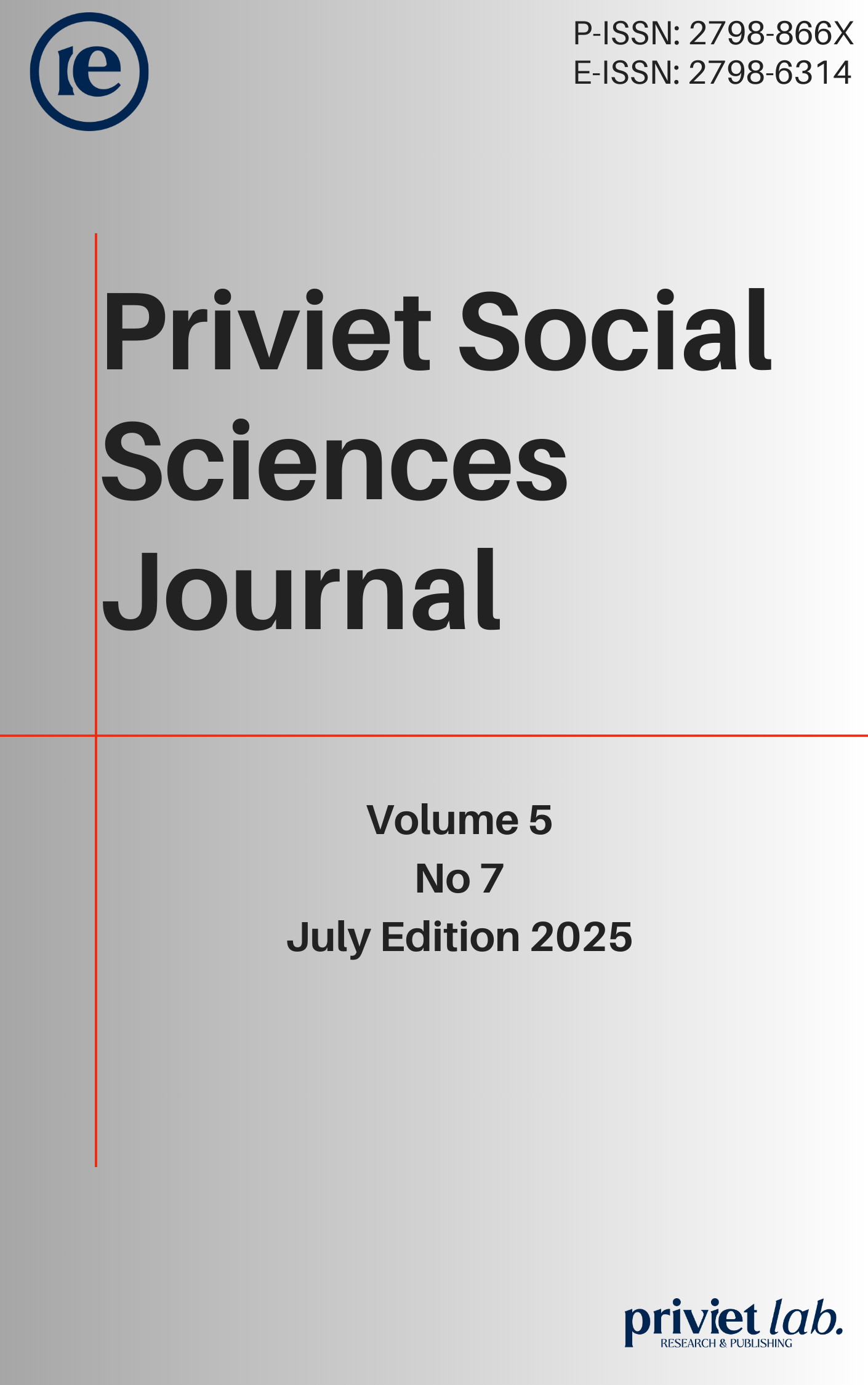Intention to reuse Gojek Application: The parallel mediating role of attitude and satisfaction toward application using AMOS-SEM approach
DOI:
https://doi.org/10.55942/pssj.v5i7.440Keywords:
Intention to reuse App, Perceived Usefulness, Attitude Toward App, Perceived Ease of Use, Satisfaction Toward AppAbstract
This study examines the influence of perceived usefulness and ease of use of the Gojek application and the intention to reuse the application with mediated attitudes and user satisfaction among Millennials and Generation Z. The focus of this research is on the big cities of East Kalimantan, Indonesia, namely Samarinda and Balikpapan. Data were extracted from 128 respondents using snowball sampling, and the analysis was conducted using AMOS structural equation Modelling. The findings show that perceived usefulness significantly affects the attitude and satisfaction of Gojek application users but has no significant effect on the intention to reuse application users. Perceived ease of use had an insignificant effect on attitudes, satisfaction, and intention to reuse Gojek application users. There is only one significant relationship between indirect variables; perceived usefulness has a significant effect on intention to reuse the application through the attitude toward the application. However, the other indirect relationships had an insignificant effect. This finding highlights the importance of perceived usefulness for Gojek application users. Although consumers admit to using an application based on attitude and satisfaction, they are reluctant to reuse the application because many competitors offer promotions and lower prices, so consumers feel they have a choice. Tests before the full AMOS model using confirmatory factor analysis for exogenous and endogenous factors showed significant results for all relationships between variables.
References
Adzawiyah, P. R., & Indriastuti, H. (2023). The Effect of Risk Perception and Customer Experience on Gopay Purchase Intention in Millennial Gen. International Journal of Economics, Business and Accounting Research, 7(4), 1330–1337. https://doi.org/10.2991/aebmr.k.200812.030
Afrina, E., Peters, R., Fanggidae, V., & Lauranti, M. (2017). Go-Jek : Kemacetan, Informalitas, dan Inovasi Transportasi Perkotaan di Indonesia. Prakarsa.
Amiri Aghdaie, S. F., Sanayei, A., & Etebari, M. (2012). Evaluation of the Consumers’ Trust Effect on Viral Marketing Acceptance Based on the Technology Acceptance Model. International Journal of Marketing Studies, 4(6), 79–94. https://doi.org/10.5539/ijms.v4n6p79
Arachchi, H. A. D. M., & Samarasinghe, G. D. (2024). Impact of embedded AI mobile smart speech recognition on consumer attitudes towards AI and purchase intention across Generations X and Y. European Journal of Management Studies, 29(1), 3–29. https://doi.org/10.1108/ejms-03-2023-0019
Bali, S., Chen, T. C., & Liu, M. C. (2024). Behavioral Intentions of Low-Achieving Students to Use Mobile English Learning: Integrating Self-Determination Theory, Theory of Planned Behavior, and Technology Acceptance Model Approaches. International Journal of Human-Computer Interaction, 0(0), 1–11. https://doi.org/10.1080/10447318.2024.2364142
Banu, A. M., Mohamed, N. S., & Parayitam, S. (2019). Online Banking and Customer Satisfaction: Evidence from India. Asia-Pacific Journal of Management Research and Innovation, 15(1–2), 68–80. https://doi.org/10.1177/2319510x19849730
Bayır, T., & Akel, G. (2024). Gamification in mobile shopping applications: A review in terms of technology acceptance model. Multimedia Tools and Applications, 83(16), 47247–47268. https://doi.org/10.1007/s11042-023-16823-7
Davis, F. D. (2013). Information Technology Introduction. Management Information Systems Research Center, 13(3), 319–340.
Ejigu, A. K., & Yeshitela, K. (2023). Exploring the factors influencing urban farmers’ perception and attitude toward the use of excreta-based organic fertilizers in Arba Minch City, Ethiopia. Frontiers in Sustainable Food Systems, 7(January), 1–15. https://doi.org/10.3389/fsufs.2023.1271811
Foroughi, B., Yadegaridehkordi, E., Iranmanesh, M., Sukcharoen, T., Ghobakhlo, M., & Nilashi, M. (2024). Determinants of continuance intention to use food delivery apps: findings from PLS and fsQCA. International Journal of Contemporary Hospitality Management, 36(4), 1235–1261. https://doi.org/10.1108/IJCHM-10-2022-1209
Gabriel, J. R., & Park, M. C. C. (2024). Unraveling the Relationship of Perceived Usefulness and Ease of Use on Consumer Attitudes towards Social Networking Sites for Tourist Destination Selection. 3(3), 207–214. https://doi.org/10.56472/25835238/IRJEMS-V3I3P128
Gupta, V., & Duggal, S. (2021). How the consumer’s attitude and behavioural intentions are influenced: A case of online food delivery applications in India. International Journal of Culture, Tourism, and Hospitality Research, 15(1), 77–93. https://doi.org/10.1108/IJCTHR-01-2020-0013
Hadi, M. A., Besra, E., & Verinita. (2022). Enrichment: Journal of Management The Effect of Perceived Risk and Perceived Usefulness on Purchase Intention with Customer Attitude as a Mediation Variable (Survey of Tokopedia Consumers in Padang City). Enrichment: Journal of Management, 12(4), 2918–2930.
Hair, J. F., Black, W. C., Babin, B. ., & Anderson, R. . (2010). Multivariat (7th ed.).
Joo, K. (2025). Exploring Consumers’ Technology Acceptance Behavior Regarding Indoor Smart Farm Restaurant Systems : Focusing on the Value-Based Adoption Model and Value – Attitude – Behavior Hierarchy. Sustainability.
Kurniasari, F., Abd. Hamid, N., & Qinghui, C. (2020). The Effect of Perceived Usefulness, Perceived Ease of Use, Trust, Attitude and Satisfaction on Continuance of Intention in Using Alipay. Management and Accounting Review, 19(2).
Lim, X. J., Aw, E. C. X., & Teoh, K. G. C. (2018). Factors influencing repurchase intention in online shopping context: The mediating role of satisfaction. Journal of Applied Structural Equation Modeling, 2(1), 29–43. https://doi.org/10.47263/jasem.2(1)04
Lubis, M., & Wardana, C. (2020). Analysis of Customer Satisfaction in Go-Food Services: Customer Relationship Management. 2020 8th International Conference on Cyber and IT Service Management, CITSM 2020, (May). https://doi.org/10.1109/CITSM50537.2020.9268855
Ma, J., Wang, P., Li, B., Wang, T., Pang, X. S., & Wang, D. (2024). Exploring User Adoption of ChatGPT: A Technology Acceptance Model Perspective. International Journal of Human-Computer Interaction, 0(0), 1–15. https://doi.org/10.1080/10447318.2024.2314358
Marzuki, M., Abdullah, D., Bahri, S., & Kamal, M. (2016). The Role of Perceived Interactivity, Perceived Ease of Use, Perceived Usefulness, and Perceived Enjoyment toward Intention to Use Online Mapping Service Applications An Integration of Graduate Competency Model for Hotel View project Hospitality Interactiv. International Academic Research Journal of Business and Technology, 2(2), 135–139. Retrieved from https://www.researchgate.net/publication/311676123
Mondal, S., & Hasan, A. A.-T. (2023). Online grocery shopping intentions in the post COVID-19 context: a case of millennial generations in Bangladesh. South Asian Journal of Marketing, 5(2), 113–130. https://doi.org/10.1108/sajm-01-2023-0001
Mukhlis, & Indriastuti, H. (2021). Customer Satisfaction Through Customer Loyalty and Customer Experience: Survey of Go-Ride Mulawarman. International Journal of Economics, Business and Accounting Research, 2021(2), 54–62.
Mulyani, V. G., Najib, M. F., & Guteres, A. D. (2021). The Effect of Perceived Usefulness, Trust and Visual Information toward Attitude and Purchase Intention. Journal of Marketing Innovation (JMI), 1(01), 78–93. https://doi.org/10.35313/jmi.v1i01.12
Olivia, M., & Marchyta, N. K. (2022). The Influence of Perceived Ease of Use and Perceived Usefulness on E-Wallet Continuance Intention. Jurnal Teknik Industri, 24(1), 13–22. https://doi.org/10.9744/jti.24.1.13-22
Or, C. (2024). Watch That Attitude ! Examining the Role of Attitude in the Technology Acceptance Model through Meta-Analytic Structural Equation Modelling Str. International Journal of Technology in Education and Science, 8(November), 558–582. https://doi.org/10.46328/ijtes.575
Pal, A., Singh, U. P., & Kumar, A. (2024). Investigating The Determinants of Online Shopping Repurchase Intention in Generation Z Customers in India: An Exploratory Studi. 19.
Pappas, I. O., Pateli, A. G., Giannakos, M. N., & Chrissikopoulos, V. (2014). Moderating effects of online shopping experience on customer satisfaction and repurchase intentions. International Journal of Retail and Distribution Management, 42(3), 187–204. https://doi.org/10.1108/IJRDM-03-2012-0034
Parvari, A., Anvari, R., Mansor, N. N. binti A., Jafarpoor, M., & Parvari, M. (2015). Technology Acceptance Model, Organizational Commitment and Turnover Intention: A Conceptual Framework. Review of European Studies, 7(12), 146. https://doi.org/10.5539/res.v7n12p146
Prihanto, I. G., Gunawan, H., Riyanto, B., Prasetio, W., Sumaedi, S., Rakhmawati, T., Mahmudi. (2024). A technology acceptance model of satellite-based hydrometeorological hazards early warning system in Indonesia: an-extended technology acceptance model. Cogent Business and Management, 11(1), 1–16. https://doi.org/10.1080/23311975.2024.2374880
Putro, A. K., & Takahashi, Y. (2024). Entrepreneurs’ creativity, information technology adoption, and continuance intention: Mediation effects of perceived usefulness and ease of use and the moderation effect of entrepreneurial orientation. Heliyon, 10(3), e25479. https://doi.org/10.1016/j.heliyon.2024.e25479
Rashid, M., Shamsi, M. A., Anwar, I., Saleem, I., & Yahya, A. T. (2025). Consumer intention to adopt e-wallets in rural India: an investigation by extending the technology acceptance model. Cogent Business and Management, 12(1). https://doi.org/10.1080/23311975.2024.2428776
Sallam, M., Elsayed, W., Al-Shorbagy, M., Barakat, M., Khatib, S. El, Ghach, W., … Malaeb, D. (2024). ChatGPT Usage and Attitudes are Driven by Perceptions of Usefulness, Ease of Use, Risks, and Psycho-Social Impact: A Study among University Students in the UAE. Frontiers in Education, 9(August), 1414758. https://doi.org/10.3389/feduc.2024.1414758
Salloum, S. A., Aljanada, R. A., Alfaisal, A. M., Al Saidat, M. R., & Alfaisal, R. (2024). Exploring the Acceptance of ChatGPT for Translation: An Extended TAM Model Approach. Studies in Big Data, 144(May), 527–542. https://doi.org/10.1007/978-3-031-52280-2_33
Saqr, R. R., Al-Somali, S. A., & Sarhan, M. Y. (2024). Exploring the Acceptance and User Satisfaction of AI-Driven e-Learning Platforms (Blackboard, Moodle, Edmodo, Coursera and edX): An Integrated Technology Model. Sustainability (Switzerland), 16(1). https://doi.org/10.3390/su16010204
Sarstedt, M., Ringle, C. M., & Hair, J. F. (2021). Partial Least Squares Structural Equation Modeling. In Handbook of Market Research. https://doi.org/10.1007/978-3-319-57413-4_15
Sumargo, Y., & Indriastuti, H. (2021). The Effect of Perceived Usefulness, Perceived Ease of Use, and Mindfulness on Attitude and Intention to Use Mobile Banking Maybank Bank (Study on people in Samarinda City). International Journal of Business and Management Invention (IJBMI) ISSN, 10(11), 47–54. https://doi.org/10.35629/8028-1011024754
Sutrisno, T. F. C. W. (2023). Digital Payment Transformation: The Role of the Technology Acceptance Model To Repurchase Intention. Review of Management and Entrepreneurship, 7(1), 1–24. https://doi.org/10.37715/rme.v7i1.3679
Tang, K. L., Tan, P. M., Hooi, R., Low, M. P., Tan, K. E., & Yeo, K. C. (2024). Predicting Continuance Intention and Use of Mobile Shopping Apps With PLS-SEM and Necessary Condition Analysis in Tandem. Journal of Applied Structural Equation Modeling, 8(1), 1–27. https://doi.org/10.47263/JASEM.8(1)02
Tiwari, P., Kaurav, R. P. S., & Koay, K. Y. (2024). Understanding travel apps usage intention: findings from PLS and NCA. Journal of Marketing Analytics, 12(1), 25–41. https://doi.org/10.1057/s41270-023-00258-y
Vandiny, V. S., Listiawati, R., Rimenda, T., & Marbun, J. (2022). The Reasons of Why Customers Choose COD as Their Payment Method When Shopping Online. Proceedings of the International Conference on Applied Science and Technology on Social Science 2022 (ICAST-SS 2022), 535–540. https://doi.org/10.2991/978-2-494069-83-1_95
Venkatesh, V., Morris, M. G., Davis, G. B., & Davis, F. D. (2003). User acceptance of information technology: Toward a unified view. MIS Quarterly: Management Information Systems, 27(3), 425–478. https://doi.org/10.2307/30036540
Wen, C., Prybutok, V. R., & Xu, C. (2011). An integrated model for customer online repurchase intention. Journal of Computer Information Systems, 52(1), 14–23. https://doi.org/10.1080/08874417.2011.11645518
Wilson, N., Keni, K., & Tan, P. H. P. (2021). The role of perceived usefulness and perceived ease-of-use toward satisfaction and trust which influence computer consumers’ loyalty in China. Gadjah Mada International Journal of Business, 23(3), 262–294. https://doi.org/10.22146/gamaijb.32106
Wu, G., & Peng, Q. (2024). Bridging the Digital Divide: Unraveling the Determinants of FinTech Adoption in Rural Communities. SAGE Open, 14(1), 1–16. https://doi.org/10.1177/21582440241227770
Yao, N., & Wang, Q. (2024). Factors influencing pre-service special education teachers’ intention toward AI in education: Digital literacy, teacher self-efficacy, perceived ease of use, and perceived usefulness. Heliyon, 10(14), e34894. https://doi.org/10.1016/j.heliyon.2024.e34894
Downloads
Published
How to Cite
Issue
Section
License
Copyright (c) 2025 Zsaghandy Adjisuastika Sudibyo, Syarifah Hudayah, Herning Indriastuti

This work is licensed under a Creative Commons Attribution 4.0 International License.

















